On 6th day of our Roopkund Journey, we descended down from Pathar Nachauni to Didna Village and covered the maximum distance of approx. 14 kms in a single day. The trail from Pathar Nachauni to Didna Village, first passes through the beautiful alpine meadow of Bedini Bugyal and Ali Bugyal, and then through the dense forest of Oak, Burans and Bamboo trees.
We started our trek at 0730 AM in a pleasant weather. The Valley below us was filled with the clouds. Black top of the mountains peeping out from the clouds were looking beautiful. We reached at Ghora Lotani. From there, we could see the vast expanse of Bedini Bugyal in front of us. It was a beautiful morning.
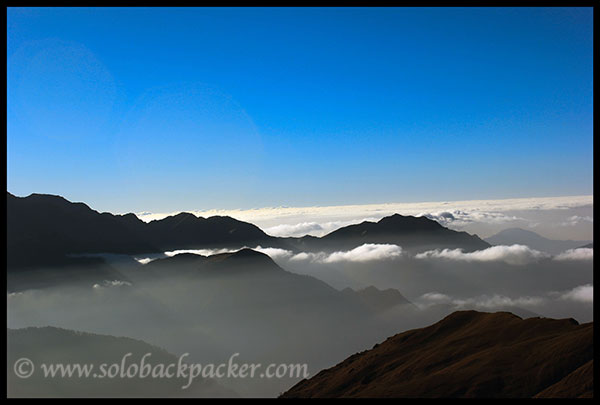
We reached Bedini Bugyal in one and half hours. The trail from Bedini to Ali Bugyal goes on the top of the hill, while camping ground and Bedini Kund is situated nearly 500 meters away below the trail. There was no facility for breakfast/lunch upto Didna on our way, where we were expected to reach about 0300 PM in the afternoon. We decided to send our guide to Pratap’s Dhaba in Bedini, so that he could arrange some breakfast for us. We proceeded on the trail to wait for him in Ali Bugyal.
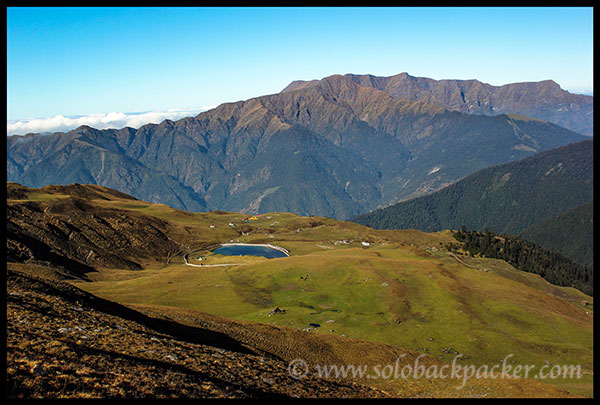
Many people were climbing to Roopkund that day. We found hundreds of people in group sizes varying from 5 people to 40 people. There were lot of foreigners also. It gave us an idea of the popularity of this trek. Interestingly, all people were on their way to Roopkund, Only we were returning from Roopkund. Most of the people had a night halt at Bedini, while some were also coming from Didna Village.
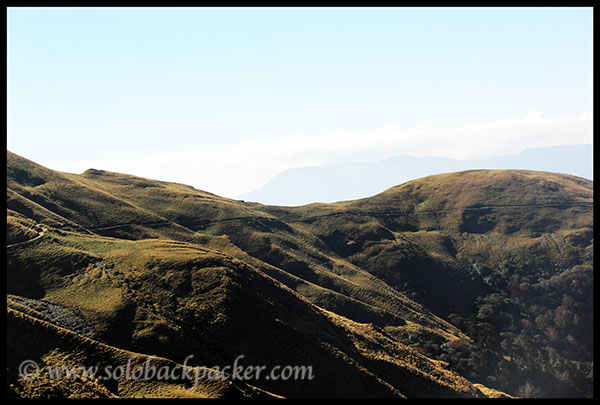
Since there was lot of time to kill before our guide would come with the breakfast, I decided to clicked some wild flowers on the way. There were lot of wild flowers in the meadow of Bedini and Ali Bugyal.
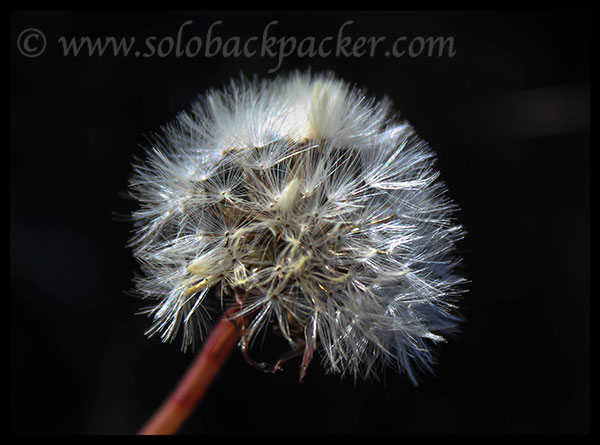
While Sanjeev and Tanvir Sir was waiting for the guide at some distance from me, a man approached them and informed that he belonged to the Forest Deptt and came there to collect the charges associated with the trek. He had all the information of our group size and our stay at fiber huts, probably provided by the guide who went to buy the breakfast. We insisted for the receipt of all the charges, but he hadn’t. He told that receipt was there at Bedini, so Sanjeev handed over him INR 500 as lumpsump charges without receipt.
Further, at the beginning of Ali Bugyal, there were two routes. One is going towards two fiber huts at least 500 meters away and other one was going towards a beautiful hill completely covered by the green grass and rising significantly from its adjacent area to end abruptly. It just looked like an edge of the world. We didn’t have any idea of the route and nobody was there to help us. So, we decided to wait there for the guide. Kaptan Sahab was way ahead of us, so he had been already moved towards the fiber huts.
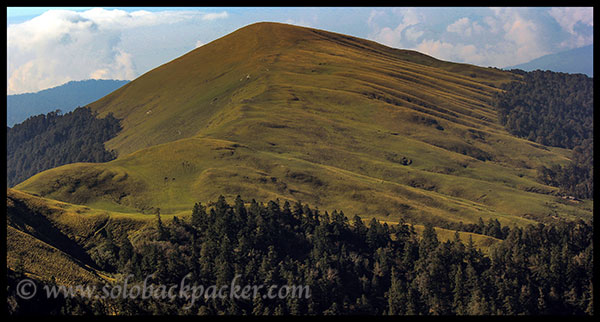
After 30 minutes, the guide arrived with some chapatis and vegetable. He informed us that Kaptan Sahab was on the wrong trail. It was a big problem. Nobody wanted to descend down to inform him and then again climb up on the same point. We looked around, but there was nobody to help us. We stopped there and had our breakfast. Then we moved towards the Ali Bugyal thinking he could see us. We couldn’t make any conversation with him, but by waving our hands, we informed him that he was on the wrong path and called him towards Ali Bugyal. Without any other option, he climbed up and joined us at the right trail.
While he was breaking his fast, we were busy clicking the views of our surrounding. White peaks of Trishul and Nanda Ghunti looks amazing from Ali Bugyal. Chaukhambha and other neighbouring peaks are also visible from Ali Bugyal. Lower side of Bugyal was covered by the dense forests. Ali Bugyal is one of the finest grassland with its unmatched beauty. A vast carpet of green grass covers this meadow from all sides.
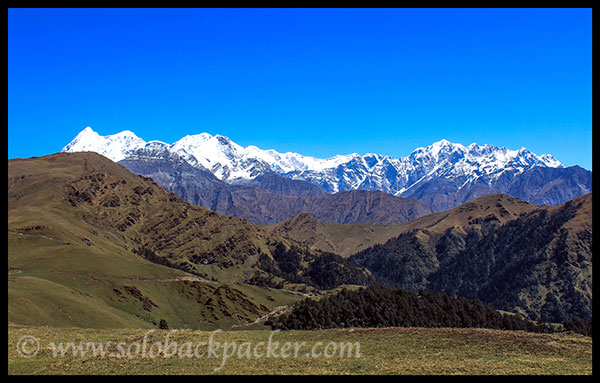
We moved further on the trail and reached to the end of Ali Bugyal near a small pool. There is two trails, one descending towards the forest and another trail moving forward towards the end of the Ali Bugyal. Our guide had already informed us that there was two trail for Didna Village. First, the longer one, moved via Tolpani while the second, descend down directly to Didna village from Ali Bugyal. The second one is about 3 kms shorter than the first one and it could save us our one hour. But the only problem is that a mule can not go on the direct trail as it is very steep.
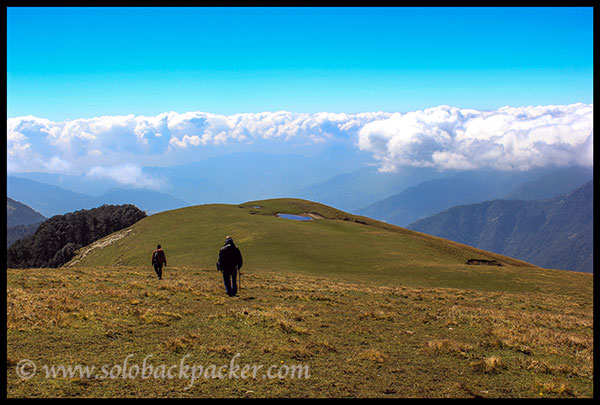
While we were moving on the trail in Ali Bugyal, our guide was left behind. When we reached near the pool and found two trails, we got confused. We looked around, but again nobody was there to help us. We shouted the name of our guide, but no reply. He was lost somewhere. Helpless, we descended on the trail moving towards the forest and reached at the beginning of the forest. There is a sudden change in the vegetation here. The land of green grass ends abruptly and suddenly starts a dense forest of Oak Trees. There is no gradual change. Thats why tree-line is so much clear from Ali Bugyal. Same thing is also at the other end of Bedini Bugyal near Dauliadhar.
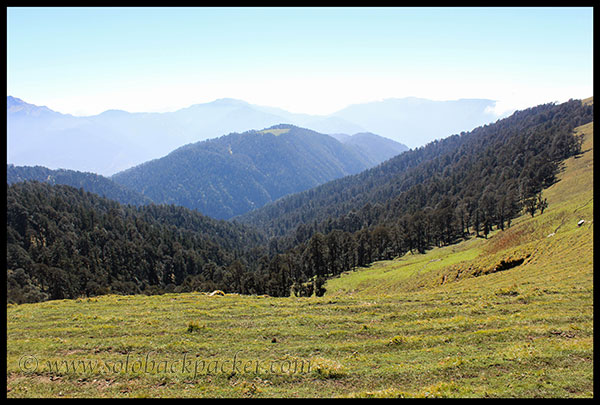
I could easily sight Lohajung, Didna and Kulling villages from there, so I decided to move on that trail. But other people said that its better to wait for the guide before moving on an unknown path. We could have lost in that dense forest.

After waiting for 30 minutes, he appeared from the Ali Bugyal to informed us that we were on the second trail, where a mule could not go. Frustrated, we didn’t want to climb again on the trail to Tolpani, so, we moved on that direct trail only. He also moved on that trail with his mule. The descend was very steep on this slippery trail. I felt down two times, while trying for the short-cuts.
The forest was very dense and we moved ahead slowly. It is a mixed forest full of Oak, Burans, Kharsu and small Bamboo trees. The rain is very frequent in that area, so there are lot of parasitic plants on the trees. In fact, the Forest Deptt launched a pilot project to remove those parasitic plants from the trees. But lot of plants were still present. Suddenly, a lady appeared from nowhere and crossed us quickly. She was running on that trail, where we were walking very slowly.

Till the middle of the forest, we consumed all the drinking water available with us and due to humidity, we were in need of more water. There was a water stream on the way, so we moved patiently. We reached to the stream, drank water and washed our face.
When, we reached Didna Village, it was about 0400 PM. We looked back on the hill, from which we just descended through the forest. It was a thrill to imagine that height. The top of the hill seemed a distant away poking into the clouds. We descended almost 3000 ft height through the forest from 11000 ft (Ali Bugyal) to Didna Village (8000 ft).
Didna is a small village situated on the edge of a mountain. The top of that mountain is at Ali Bugyal, 3000 feet above, while the base is at Neelganga River, further 600-700 ft down from Didna Village. There are lot of descend still left after Didna to reach the river, cross the bridge and again climb upto Kuling village. This is the main reason to start our trek via Wan Village rather than Didna Village. From Lohajung to Wan, the road is almost parallel, while Lohajung to Didna, first, you have to descend to the Neel Ganga River and then there is a steep climb to Didna Village.
There is 3-4 guest houses in Didna. We stayed in the guest house of Mahipat Danu at very reasonable rates (INR 300 per person). It has a nice dormitory with clean beds and quilts. The dinner and breakfast charges were included in the dormitory charges. Dormitory is also available without the food at nominal charges (INR 100 per bed). Hot water facility is available at the cost of INR 30 per bucket.
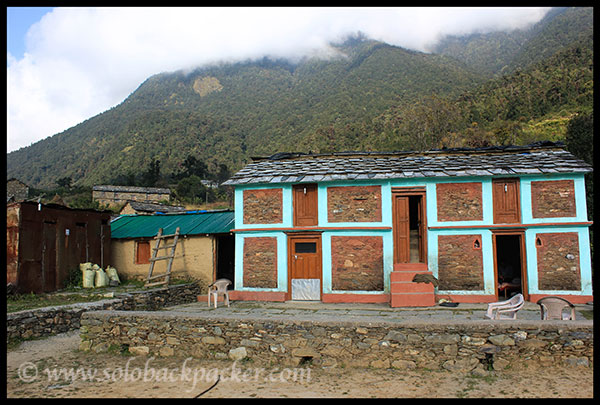
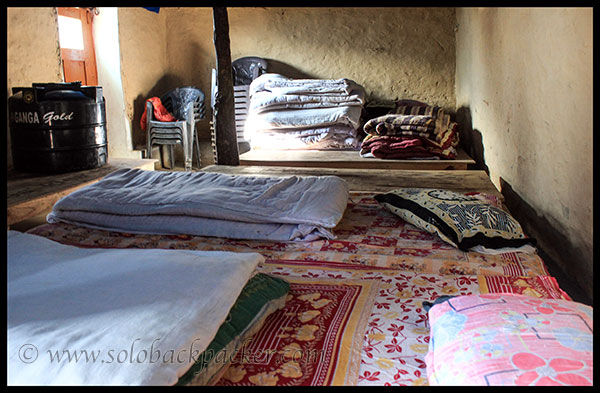
In the evening, we went for a walk around Didna Village. Majority of the houses in the village are two storeys and made of stone bricks. The lower portion of the houses are used as a yard for cattle, while people used to live at the upper portion. Guest-houses used both storey as a dormitory.There is no road to the village, so it is not accessible by a vehicle. Electricity is also not available, however, some houses have the solar panel. Some houses also have the TV Antennas for the entertainment purposes. Mobile networks are also available in the village.
In a cluster of houses, some women were drying Rajmas, smaller in size than we usually buy here in Delhi. They also had lot of Gaanja, drying outside the house. Later, we found some plants of Gaanja in the village. We bought some Rajma as it was totally organic and without any chemical.
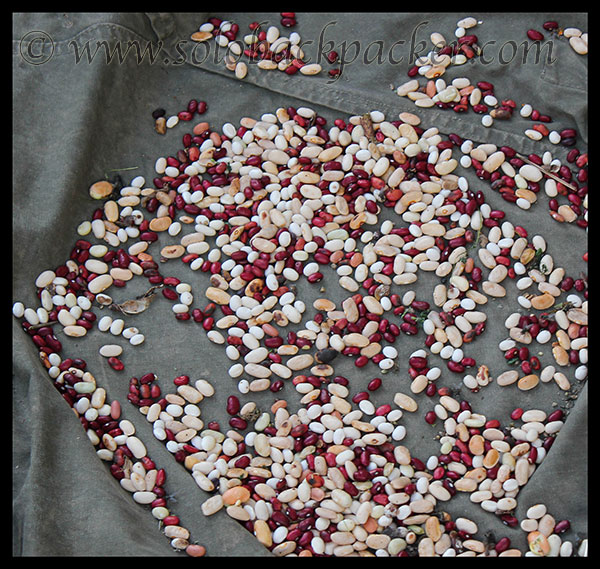

An old person of the village informed us that a long ago there was a plan to build a rope-way from Didna to Ali Bugyal, but by mistake in the government papers Ali became Auli and they built the famous rope-way from Joshimath to Auli. He informed that the rope-way is again on the card and expected to build soon in the future. It will be a huge boost for the tourism in this area.
In the night, we had a nice dinner at the guest house. Next day, we trekked down from Didna to Neelganga River and then climbed upto Kulling Village. Further, we walked on the road to Lahajung to catch a jeep for return journey. My next post will be on our trek from Didna to Lohajung via Kulling Village.


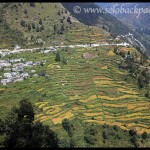
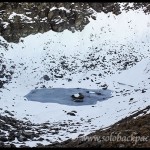
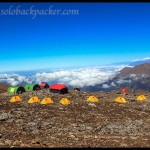
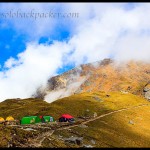
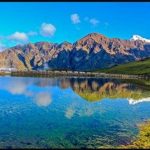
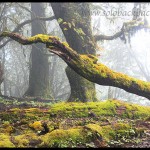
I am fan of your blog.. every time I plan for a trek, 1st search your blog for information. You have a God gifted writing skill.
About the project of rope-way, I think these are rumors. People in Raithal villages said something similar to us when we were there for dayara bugyal trek – due some documentary mistakes by government personal the project shifted to Auli.. 😀
Hehehe..Thank You for this information. It may be rumours only. At tourist places, people are good to make the stories and then all tourist activities revolve around those stories. Travels and rumours move together. And, Thanks again for the appreciation. 🙂
you are welcome. Can you please tell us how did you manage camera battery live for so long?
I have two set of batteries for Canon EOS 550 D camera. So, it is good enough for 4-5 days, even after clicking lot of pictures. 🙂
can i know which year and month you visited……..?
Hi, we went there in October, 2013.
This is best description I ever read about roopkund trek.. So hats up to you.. Being a native of village Wan ( but living in Delhi), i can relate to it. I have only regret that you havent spent a more day in Wan to explore its flora and fauna. Thanks
Hi, may be next time I have enough time to explore Wan and around. I would surely love to visit again.
A nice account and all the pictures are so gorgeous! I’d love to visit it.
Picturesque and Exquisite!
Loved the parasitic fungi and every capture of the mountains, you’ve shown!
Everything that you wrote here looks so exciting but have heard it’s very difficult trek from whoever has gone there. They had trained themselves for months & still found difficult to climb. Your account is quite detailed telling us the problems faced in these treks.
Rs 30/- bucket is very cheap, at places they charge no less than 50- 100. 🙂
Its a difficult trek indeed, but with a proper planning it is doable in a comfortable manner. In my opinion, the success of this trek highly depends on the weather conditions, so it is very tricky to choose the right time for this trek. Overall, its a nice trekking experience at a reasonable price. 🙂